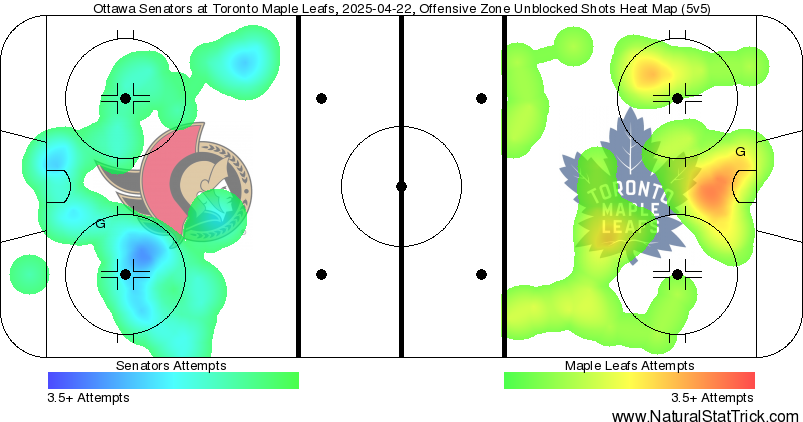For the first time in 23 years, the Toronto Maple Leafs lead a playoff series 2-0.
In Game 2, a torrid start gave way to an awful second period and a much stronger lock-it-down third before a tricky deflection goal evened it up. The teams went to overtime, and the tandem of Simon Benoit and Max Domi played unlikely heroes in Scotiabank Arena to give the Leafs a commanding grasp on the series. Now, we’ve had a day to digest what we’ve seen through two games, how the Leafs can keep their foot on the gas, and the possible paths for Ottawa to crawl back into the series.
Notable Performances in Game 2
They didn’t score at even strength, and we’re still waiting for the first Auston Matthews goal of the series, but Game 2 was better from the Leafs‘ top line. Mitch Marner should have scored on the first look two minutes into the game, but the group won their minutes and weren’t bogged down in the defensive zone while seeing much more of the Shane Pinto line than in Game 1, as Travis Green chased this matchup more than he did in the series opener. That’s a positive sign with the series about to head on the road, where Green has more matchup control.
The addition of Pontus Holmberg to the second line paid reasonable dividends, as Holmberg drew the penalty preceding a power-play goal, missed a partial breakaway chance, and, more than anything, showed that his work rate and puck-protection skills could help this unit play more on offense.
Craig Berube showed confidence in the Scott Laughton line by starting Game 2 with them, and they rewarded him by winning the shift territorially and getting the team into the game with a lively, physical shift. It was a low-event night for the line otherwise, but that’s objective #1 when they’re taking around four minutes of the Stutzle matchup at five-on-five (absolutely nothing happened in those minutes; a total of one shot attempt for Ottawa between the two teams). Particularly on the road, a bottom-six line trustworthy enough to withstand a tough matchup for a handful of shifts — and chip in the odd goal — is a major positive development from the Leafs‘ perspective.
The bottom six “scoring” line of Domi, Nick Robertson, and Bobby McMann remains an area of real concern after a pretty poor game right up until Domi played the hero in the end. Robertson took a terrible penalty in the second period — a high stick in the offensive zone with the puck gone — that led to Ottawa’s first goal, and he was benched afterward, taking only a couple of shifts the rest of the game. One of those shifts was the game-tying goal, which wasn’t on Robertson, but it was scored against that line. It’s also fair to ask the question why this line was playing at all, especially alongside the team’s third pairing, in the final ~five minutes of a one-goal game.
Oliver Ekman-Larsson’s game was full of bite and stellar defense despite the one bad giveaway, while Simon Benoit played hero in overtime — broke up the pass, led the breakout, had the confidence to drop a pass inside the line, and then applied the screen in front on the game-winner by Domi. Benoit played 19:56 in a winning playoff effort, which is a remarkable series of words to write after stretches of the regular season where Benoit was struggling so mightily. All in all, the Leafs have to feel good about the state of their defense core pairings one through three.
And even better about their goaltending. Anthony Stolarz earned his second career playoff win in net with another confidence-inspiring performance. The first goal he allowed was an attempted pass that doinked in off Brandon Carlo in front (not much could be done about that), and the second goal was a wicked/unstoppable deflection. It took two nasty deflections to beat Stolarz, who is stopping everything he is seeing, and the Leafs are keeping his sightlines relatively clear. Through two playoff games, Stolarz is 2-0 with a .934 save percentage and is now riding a 10-game winning streak dating back to the regular season. The Leafs’ edge in net has been a canyon through two games.
Storylines for Game 3
1. The Maple Leaf penalty kill. The Senators scored their first power-play goal of the series in Game 2, and they also scored at 6-on-5 with a delayed penalty in Game 1. Ottawa’s power play has put four shots on Anthony Stolarz for every two-minute power play. Ottawa spent 4:58 of Game 2 on the power play, per Natural Stat Trick, and in that time, they took 12 shot attempts, put nine shots on net, created eight scoring chances, and five high-danger chances. They created 1.24 expected goals for in those nearly five minutes.
Those metrics speak to the overall zone time generated by the Senators and point to the entries as a starting point for Toronto. They’re not making life hard enough on the Senators through the neutral zone or in the faceoff circle, where they’re 5-for-11 shorthanded through two games.
It’s also notable that the Senators scored their power-play goal with Brady Tkachuk on for an extended/double shift after their top unit changed off at the 50-second mark. We may see the Sens try more of the same, and the Leafs will need to stay strong on #7 in front of the net/remain vigilant throughout the PK, knowing the Sens lean on two units more than Toronto and may look to spot Tkachuk into their second group.
2. The unstoppable Maple Leaf power play. On the flip side, the five-forward power play looks as good as any playoff PP has looked during the Matthews/Marner era. They got only one opportunity in Game 2 and needed just 18 seconds for John Tavares to zip a pass intended for Matthew Knies, which ricocheted off the body of Nick Jensen and in. It doesn’t look like the Senators have an answer for Knies in front of the net, and Tavares and Knies are feasting in tight against the Senators’ diamond PK.
The Leafs now have four power-play goals in two games and have looked dangerous on nearly every PP while scoring four goals almost immediately after the start of the man advantage. If the Leafs can sustain a little more offensive-zone time over the 60 minutes — similar to their Game 2 first period in terms of breakout execution and forechecking pressure — and draw a few more calls in Game 3 than Game 2, it would stack the deck further in their favour in this series.
3. Ottawa’s five-on-five offense problem. A primary reason for the concern about stopping Toronto’s PP if you’re the Senators is the fact that the Leafs’ PP has outscored Ottawa’s five-on-five offense through two games. After struggling with five-on-five offense all season, the Sens have just two five-on-five goals in the first two games of this series, and they aren’t creating much of anything, either.
Even during the periods where they hem the Leafs in and cycle with possession, they aren’t consistently getting to the hardest areas. Case in point in Game 2 (again via NST): the Senators took 63 shot-attempts in nearly 58 minutes at five-on-five, yet created only nine high-danger chances and 1.33 expected goals in that time. Look at the Game 2 heat map at five-on-five:
The Leafs’ largest cluster of shots is right around the crease/front of the net. The Senators have created a few looks from that area, but their most common shots are from the left circle and the right point. Against a goalie who is humming like Stolarz, it’s a recipe for success for Toronto. The Leafs need more of the same from Stolarz while continuing to do their part in terms of boxing out, getting in shooting lanes, and protecting the house.
4. Lineup changes for Game 3? Craig Berube did not insert any new players into the lineup for Game 2, but he did shuffle the lines by promoting Pontus Holmberg. Does he alter a winning lineup in Game 3?
The obvious change would be to sub out Nick Robertson, who has one shot through two games, has not found the score sheet, and continues to take bad penalties. That line (whether you call it the third or fourth line) remains a problem, and bringing someone new into the lineup makes some sense in theory. Max Pacioretty could play with McMann and Domi, but what is the state of Pacioretty’s game right now, and how much better of an overall line is it with Domi still at C, really? David Kämpf could push Domi to wing and help the penalty kill, but it’s hard to form a line combination that makes much sense or has any familiarity together with Kämpf in for Robertson (McMann-Kämpf-Domi)? It all feels a little awkward, given the Leafs aren’t touching their top line, their Tavares-Nylander duo, or their Lorentz-Laughton-Jarnkrok line at this time.
We knew that this Domi-Robertson line would be a question mark going into the playoffs after the lack of solutions in the final weeks of the regular season, and it has yet to resolve itself. There isn’t a totally clear and obvious path to take with a Robertson swap, but could the right personnel tweak by Berube turn the Leafs from a three-line to a four-line team?
5. The Senators’ backs are against the wall. Yes, coming from 3-0 down to win a series isn’t an impossible lift in hockey. But it’s really difficult. It has only happened four times in NHL history, roughly 2% of all instances in which a team has trailed 3-0 in a series. It would seem even more difficult to do as a young and inexperienced, first-time playoff team. The Senators will approach Thursday night like their season is on the line, and the Leafs need to be ready for it.
Game 2 was reassuring in this regard. The Senators were coming off a lopsided Game 1 loss, should’ve been the more desperate team, and yet were outclassed by the Leafs to start the game. But the matchup game has shifted with the last change changing hands, and the Leafs are (technically) on the road now. We don’t need to cite all of the examples from recent history of Leafs playoff series getting harder as they wear on, and how difficult it is to step on the throats of a down-and-out team when it is cornered. This will be the next test of the Leafs’ maturity as a team after they managed the ebbs and flows/momentum swings of the series quite well on home ice through two games.
The Leafs have been the better team when the score is tied in this series. But it’s possible we see a desperate Senators team make a credible push earlier in the game for the first time in the series, versus mounting their push only once trailing. If it happens, the Leafs will need to weather the storm by making proper breakout passes to solve the Sens’ forecheck and move up ice, versus just defaulting to throwing pucks away and packing it in defensively.

































